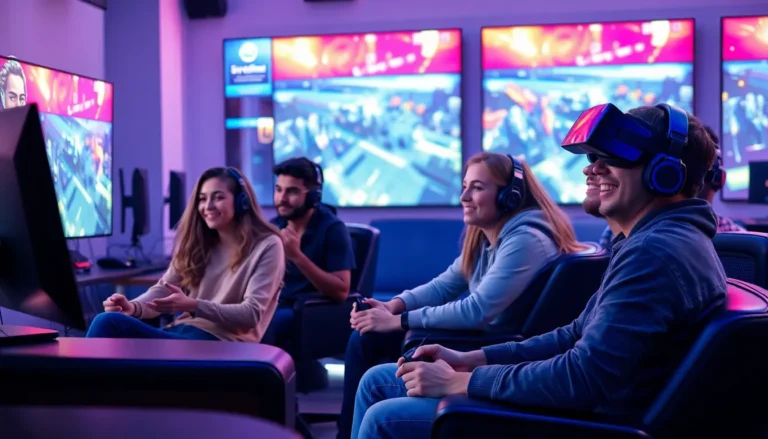Nextgen gaming isn’t just a buzzword; it’s a revolution that’s changing how players experience their favorite pastime. Imagine diving into worlds so immersive that you forget you’re sitting on your couch in your pajamas—though let’s be honest, who wouldn’t want to game in style? With jaw-dropping graphics and lightning-fast load times, the future of gaming promises to be as thrilling as a rollercoaster ride, minus the motion sickness.
Nextgen Gaming
Nextgen gaming represents a significant leap in the evolution of video games. This new era leverages cutting-edge technology to enhance player experiences. It includes features such as highly detailed graphics, which create visually stunning environments. Load times are drastically reduced, resulting in seamless transitions between game scenes.
Immersive storytelling captures players’ attention, making them feel as if they are part of the narrative. Environments become more interactive, with dynamic weather and day-night cycles influencing gameplay. Innovative hardware capabilities, including advanced graphics processing units (GPUs) and high refresh rate displays, contribute to improved gameplay fluidity.
Online connectivity enhances multiplayer experiences, allowing players to engage with others around the world in real-time. Virtual reality (VR) and augmented reality (AR) technologies further elevate gaming by offering unique ways to interact with digital worlds.
User interfaces are more intuitive, providing players with streamlined navigation. Cross-platform capabilities allow gamers to enjoy titles across various devices, promoting inclusivity. Enhanced artificial intelligence (AI) makes non-playable characters (NPCs) more realistic, reacting intelligently to player actions.
Nextgen gaming aims to create a comprehensive ecosystem. This ecosystem focuses on consistent updates, enriching content, and a vibrant community engagement. As technology continues to advance, the possibilities for nextgen gaming will expand, creating even more immersive and exciting experiences for players.
Key Features of Nextgen Gaming

Nextgen gaming brings a host of features that elevate the player experience beyond previous generations.
Enhanced Graphics and Performance
Graphics quality sees significant upgrades, with resolutions reaching up to 8K and frame rates reaching 120 frames per second. Technologies like ray tracing provide realistic lighting, reflections, and shadows, making games visually striking. Load times dramatically decrease due to SSD technology, allowing players to dive into action within seconds. Improved draw distances mean expansive worlds come alive without visual distractions. Additionally, high refresh rate displays enhance fluidity, offering smoother gameplay. Game developers leverage these capabilities to create visually stunning environments that captivate players.
Innovative Gameplay Mechanics
Gameplay mechanics undergo transformation with the introduction of adaptive triggers and haptic feedback, providing immersive sensations during gameplay. Players experience different resistances while shooting or performing actions, enhancing realism. Advanced AI capabilities make NPCs react intelligently, creating responsive and dynamic interactions. The integration of open-world elements allows for exploration and player-driven decisions that shape narratives. Cross-platform play unites diverse gaming communities, fostering collaboration. Customization options enable players to tailor experiences to their preferences, enhancing engagement and personal investment in the game.
Platforms Driving Nextgen Gaming
Nextgen gaming thrives across multiple platforms, each contributing unique features and experiences that enhance gameplay.
Consoles
Consoles like PlayStation 5 and Xbox Series X lead the charge in nextgen gaming. These machines deliver 4K and up to 120 frames per second for breathtaking visuals. Players enjoy quick load times due to SSD technology, which eliminates lengthy waiting periods. Exclusive titles often enhance the appeal of these consoles, drawing gamers into rich, immersive worlds. Features such as adaptive triggers and haptic feedback elevate the gaming experience, allowing players to feel the weight of their actions.
PC Gaming
PC gaming offers unparalleled customization and performance flexibility. Gamers can upgrade components like graphics cards and CPUs to maintain cutting-edge performance. Support for resolutions exceeding 8K and high frame rates enhances visual clarity. Furthermore, advanced gaming setups with multiple monitors create expansive experiences. The ability to mod games allows players to personalize their interactions within virtual worlds. Streaming capabilities enable content creators to share experiences in real-time, fostering community engagement.
Mobile Platforms
Mobile platforms revolutionize accessibility with gaming on the go. Devices such as smartphones and tablets offer impressive performance capabilities, driving engagement anywhere. Many titles leverage cloud gaming technology, allowing access to high-quality games without the need for powerful hardware. Touch controls and motion sensors provide unique interaction methods that cater to diverse player preferences. Additionally, augmented reality games like Pokémon GO blend real-world experiences with gameplay, creating dynamic environments for players. Mobile gaming continues expanding, reaching new audiences beyond traditional console and PC markets.
The Role of Virtual and Augmented Reality
Virtual reality (VR) and augmented reality (AR) play pivotal roles in nextgen gaming, transforming how players interact with digital environments. VR immerses players in fully realized worlds, allowing them to experience games from a first-person perspective. Players can explore these virtual realms through advanced headsets, which enhance realism by simulating 360-degree views.
AR, on the other hand, integrates digital elements with the real world. This technology overlays graphics on real-life settings, permitting players to engage with gaming experiences in their physical environments. For example, games like Pokémon GO showcase AR’s potential, encouraging players to venture outdoors and discover virtual creatures in local parks.
Both VR and AR enhance gameplay by creating more engaging experiences. Dynamic environments powered by these technologies respond to player actions, influencing how the game evolves. The introduction of intuitive controls in VR allows players to physically manipulate their surroundings, fostering a sense of presence that traditional gaming doesn’t provide.
Immersive storytelling thrives in VR, where narratives unfold based on player choices. Character development takes on new dimensions in these environments, making interactions feel more genuine. As technology advances, the gap between player and game narrows, resulting in a more cohesive experience.
Hardware advancements drive improvements in VR and AR capabilities. High-resolution displays paired with advanced sensors enhance visual fidelity and tracking accuracy. Additionally, the reduction of latency in VR headsets leads to smoother experiences, minimizing motion sickness and keeping players engaged longer.
Future developments foreshadow even deeper integration of VR and AR in nextgen gaming. Players can expect innovations that will expand accessibility, improve graphics, and create more lifelike interactions. The convergence of these technologies promises to redefine entertainment, drawing more individuals into immersive gaming communities.
Future Trends in Nextgen Gaming
Future trends in nextgen gaming focus on several key advancements. Game developers leverage artificial intelligence to enhance NPC behavior, making them more adaptive and engaging. Innovations in virtual reality set the stage for even more immersive experiences, with upcoming headsets expected to offer higher resolutions and broader fields of view. Augmented reality continues to gain traction, further blending digital and physical worlds, which encourages creative gameplay in diverse environments.
Cross-platform play gains popularity, allowing broader communities to interact seamlessly. Players benefit from this inclusivity as games become more accessible across various devices. Enhanced cloud gaming technology facilitates remote play, providing options for gamers regardless of their hardware capabilities. Future iterations of consoles and PCs are expected to maintain support for 8K resolution, improving graphic fidelity significantly.
Developers pay close attention to player feedback, which shapes the design of more personalized gaming experiences. Advanced haptic feedback systems will create tactile sensations, enriching the realism of gameplay. Game mechanics evolve with the introduction of new gameplay styles that provide fresh challenges and opportunities.
Moreover, continuous updates and expansions promise to keep players engaged long after initial releases. Marketing strategies expand, integrating community input to drive development decisions. As multiplayer experiences evolve, stronger social features will facilitate connections among players, fostering long-lasting friendships.
In this rapidly changing landscape, key partnerships between hardware manufacturers and game developers will propel technological advancements. Collaborative efforts are essential for crafting competitive ecosystems that cater to varied player interests. Emphasis on quality experiences along with technological leaps will define the next generation of gaming.
Conclusion
Nextgen gaming is reshaping how players interact with digital worlds. With its stunning visuals and immersive storytelling it captivates audiences like never before. The blend of advanced technologies such as AI VR and AR creates experiences that feel more real and engaging.
As the industry evolves players can expect even more innovation. Enhanced graphics faster load times and dynamic gameplay will continue to push boundaries. The focus on inclusivity through cross-platform play and cloud gaming ensures that everyone can join in on the excitement.
The future of gaming is bright and full of possibilities. As developers listen to player feedback and refine their approaches the next generation promises to deliver unforgettable experiences that redefine entertainment.




